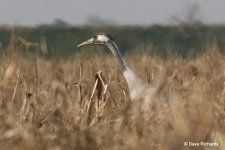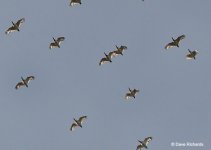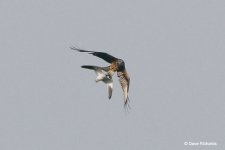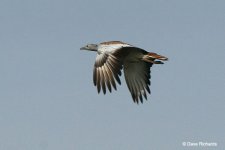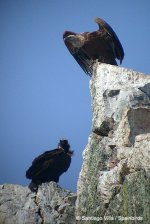Spainbirds
Santi - Spainbirds
LONG WEEKEND TRIP TO EXTREMADURA
12-14 January 2007
During the last British Birdwatching Fair which takes place every year in Rutland Water, Spainbirds & El Tenado Birdwatching Centre organized a raffle for all the assistants who came to see us to our stand in the marquee 1. The prize was a free long weekend in Extremadura for two participants to see mainly the wintering Common Cranes and all the resident species, specially raptors and steppe birds. The trip included two nights accommodation in the charming cottage of El Tenado, near Trujillo, all meals, ground transport from the Madrid airport and guide services. The value of the prize including all the mentioned expenses was estimated in ₤ 700.
From a total of the 127 tickets a boy picked the winner on Sunday 20th August who was Mr. Dave Richards from Suffolk. Dave came to enjoy his prize with his friend Trevor. After an intensive three days excursion this is the trip report of all we saw in Extremadura.
Friday, 12th January 2007: Plains and Arrocampo reservoir
After collecting Dave and Trevor at Madrid airport and a brief stop for a coffee we headed into the Calera y Chozas plains (Toledo province) trying for our first target bird: Great Bustard. That morning was clear and sunny, far from the miserable weather in that moment in England. We saw very soon our first Corn Buntings and Crested Larks of the trip, lots of Lapwings were also very distinctive almost everywhere, and dozens of Spotless Starlings were going back and forth in the fields. In less than 10 minutes and in one of the traditional places where males display in Spring we found a party of 14 Great Bustards, all of them males but one, a solitary female. We decided to have a better view using the telescope and we noticed soon that one of the males was more excited than the rest. Suddenly the male started to display showing all the white feathers of the underside of his body. It was very surprising to see this in mid January, an estrange behaviour which could be only possible being a young animal although the bird was showing a quite broad neck and the typical long bristle like feathers of the adults. A party of 5 Common Cranes flew overhead showing especially well whilst were doing their unmistakable call.
White Storks were also well present here, although some were already seen even from the road near Madrid, whilst at least three different Southern Grey Shrikes were perched along the telegraph wires parallel to the sandy road which crosses the area. As it was time for a lunch we then moved to a nearby pond where Mallards, Common Teals and a couple of Gadwalls took off once they saw our vehicle. Our stop was not as productive as expected so we decided to drive towards our next spot immediately after our picnic, the Arrocampo reservoir, seeing before leaving the plains several parties of Red-legged Partridges, Common Kestrel, Common Buzzard and a male Marsh Harrier. The works in the road to Oropesa made the journey longer than expected, and a pair of beautiful Black Redstarts displayed for us making to forget the terrible surface for a while. We finally reached the reservoir at 15:30 when it was still quite warm.
Close to the reservoir we found a Black-shouldered Kite sitting on an electricity pylon. The view was much better once it took off and then a second bird quickly joined it. Both flew together for a couple of minutes to disappear in the distance in a very low flight, perhaps heading into the feeding fields placed in the north of Arrocampo.
Purple Swamp Hens were soon detected by their typical nasal calls. Although everything was very quiet we could see Spanish Sparrows, Cetti’s Warbler, Western Marsh Harrier, the first Barn Swallows of the year, Little Egret and a Penduline Tit seen by Dave, who even thought to see for a second a dull like Bluethroat in a quite distinctive posture raising the tail up.
We were not success with the two over wintering Bitterns which it seems to be there from late December, and unfortunately we missed some of the Squacco Herons present all year round in this spot too. After all we managed to see Great Bustards, Common Cranes, Southern Grey Shrikes, Penduline Tit and Black-shouldered Kite so we couldn’t complain at all in our first day trip.
In El Tenado we allocated rooms having our dinner at eight o’clock. We all three had a brief conversation while drinking some acorn liquor offered us by Marisol after our meal, but it had been a very long day for Dave and Trevor and they went to sleep.
We were sharing the cottage with a party of Finnish wildlife photographers led by Dick Forsman so it was an immense pleasure for Santi to chat with him about the raptors and other species present in the area in the winter, especially about the controversial records of Long-legged Buzzards seen in Southern Spain in the recent years.
Saturday 13th January 2007: Monfragüe National Park
Our plan for the second day was to visit the well known Monfragüe National Park, so after a wonderful breakfast we headed towards that place crossing the “dehesa” fields between Trujillo and Torrejón El Rubio. Just before reaching the first watch point at the famous Salto del Gitano we briefly stopped join the main road to enjoy the view of +300 Griffon Vultures flying over our heads. Even we didn’t need to leave the vehicle because the sunroof of the car gave us the chance to see such “vultures’ performance”. The morning was quite cold and windy, which probably made not to see a wide variety of raptors in this point, just Griffons and more Griffons. However we really enjoyed the views of a male Blue Rock Thrush, hundreds of Crag Martins fly catching over the cliffs of Peñafalcón, a couple of Serins and two Black Vultures mixed within the Griffons flock. After scanning the cliffs trying to see Rock Bunting without success we moved towards the hamlet of Villarreal de San Carlos where we had a coffee and a hot chocolate. A surprisingly tame Crested Lark came to us the enough close for taking some pictures in spite of the bad light of the moment.
Next stop would provide us the opportunity to see a pair of Bonelli’s Eagles displaying first and then sitting down several times in the eucalyptus trees where they bred the previous year. What a magnificent birds! We had enough time to discuss about the unmistakable silhouette of this raptor… the short and rounded wings and a long tail reminded us like a big Goshawk more than an eagle-like bird.
Dartford and Sardinian Warblers were calling there into the dense Gum Cistus scrubs and flocks of Azure-winged Magpies moved down in the valley whilst doing their typical contact calls.
The next two stops at La Tajadilla and near La Báscula didn’t get us the chance to see Hawfinch or Crested Tit so we decided then to make a move to La Portilla watch point, the traditional place for the Spanish Imperial Eagle. Once we arrived and checked the old nest used by the eagles on the last two seasons we sadly saw that the bird laying down was a Griffon Vulture. However at least one the eagles were still around and its call was heard for a while just behind the cliffs. A couple of Black Vultures then appeared and one of them landed at the top of the rocky area next to a Griffon giving us the chance to compare every single difference between them. Another Blue Rock Thrush was seen in the opposite bank whilst a small party of Cormorants was having a relaxing sun bathing.
Our intention then was to visit another spot for Spanish Imperial Eagle south Monfragüe but we decided to stop briefly in the watch point of the Puente del Cardenal and trying again for Rock Buntings. We missed the bunting but we had terrific views of another pair of Bonelli’s Eagle, in fact they were so close that we didn’t need our binoculars to see every single feather. Superb! But that was not all and before leaving the park a Golden Eagle displayed well just over head giving us the chance to take some pics...
At the second Spanish Imperial Eagle’s spot we managed to see the two adults sitting on a pylon but the distance unfortunately was quite considerable. Here a very tame Kingfisher and a couple of Thekla Larks were also recorded. The plan for the late evening was to see the Common Cranes coming to roost into the Talaván reservoir. We knew about a long staying juvenile Greater Flamingo present in the reservoir too and there certainly it was. We decided to go to the opposite side of the reservoir with the intention to a have a closer view of the Flamingo but a Rock Sparrow perched on a fence made us to stop to see it from the vehicle itself. The temperature was then cooler and we decided then that it was to come back to the cottage.
Sunday 14th January 2007: Rice paddies & plains
Our third day was also quite productive. After breakfast and say good-bye to Marisol we headed towards de rice paddies near Madrigalejo. The first stops gave us the chance to see the first Golden Plovers of the trip, an incredible number of Moorhens feeding on the surroundings of a quite small pond and a couple of Red Kites soaring at the distance. Suddenly we could see two white spots on the top of an oak. They were two beautiful Black-shouldered Kites. We really enjoyed the views through the telescope of the two birds perched until a Red Kite decided to cross their territory. Then presumably the male of the pair Black-shouldereds took off and both species of kites were chasing each others for at least five minutes in front of us, offering of course one of the highlights of the trip. The much bigger Red Kite soon desisted and disappeared at the distance.
The surroundings of Sierra Brava reservoir are probably one of the best places to see large flocks of wintering Common Cranes in the whole Extremadura, unfortunately there were some hunters around and just a few loose family parties were seen in this spot. However we were very lucky with a flock of Little Bustards which flew overhead several times. The whistling wing sound of about 50 of these birds was quite impressed.
Lots of Red Avadavats, an introduced species, were going back and forth around the rice paddies whilst several Fan-tailed Warblers, Crested Larks and Lapwings were also seen.
At least four Hoopoes sitting in the same tree, one of them singing very active, and two more Black Shouldered Kites were observed before heading to the damn of the reservoir.
From the damn thousands of ducks were seen, the light was good but the distance quite important. Amongst the most interesting things here both Crested and Thekla Larks almost together and an impressive number of Shovelers… maybe more than 3.000 birds.
After our brief visit to the reservoir we moved to the plains of Campo Lugar. Here lots of Lapwings, Skylarks, Corn Buntings and a few Calandra Larks, one of the target species for Dave and Trevor. We had our lunch in that spot with a fabulous weather but we decided to move to the plains near Trujillo and trying for sandgrouse before getting later.
Once at the plains Great Bustards were soon seen. At least 50 plus birds in separated parties. Then a Black-bellied Sandgrouse crossed flying low at the distance. Attending the face expression of the two participants I presumed that was one the most wanted birds for both. It was a nice adult showing all the features of the species, orange spots on both sides of the neck, heavy markings on the back, distinctive black on the belly, short legs and an incredible camouflage which didn’t allow us to have closer views of the bird when decided to move and try it.
Then we heard at the distance the unmistakable call of the Pin-tailed Sandgrouse being found in the sky coming towards us. Five of these birds then flew soon overhead showing very well and disappear in the distance few seconds later… we had managed to see both species of sandgrouse in the same spot and in less than 10 minutes!
After the sandgrouse experience we then drove back to Madrid. We had a journey of about 3 hours reaching the Madrid airport with plenty time for the flight back to England.
I just want to say thanks to Dave and Trevor for their company and good sense of humour… I hope to see you both again very soon!
Santiago Villa
www.spainbirds.com
If you wish to see the checklist to all the species recording during the weekend then click on: http://www.spainbirds.com/ing/july2005/tripreports/longweekendenero07.pdf
12-14 January 2007
During the last British Birdwatching Fair which takes place every year in Rutland Water, Spainbirds & El Tenado Birdwatching Centre organized a raffle for all the assistants who came to see us to our stand in the marquee 1. The prize was a free long weekend in Extremadura for two participants to see mainly the wintering Common Cranes and all the resident species, specially raptors and steppe birds. The trip included two nights accommodation in the charming cottage of El Tenado, near Trujillo, all meals, ground transport from the Madrid airport and guide services. The value of the prize including all the mentioned expenses was estimated in ₤ 700.
From a total of the 127 tickets a boy picked the winner on Sunday 20th August who was Mr. Dave Richards from Suffolk. Dave came to enjoy his prize with his friend Trevor. After an intensive three days excursion this is the trip report of all we saw in Extremadura.
Friday, 12th January 2007: Plains and Arrocampo reservoir
After collecting Dave and Trevor at Madrid airport and a brief stop for a coffee we headed into the Calera y Chozas plains (Toledo province) trying for our first target bird: Great Bustard. That morning was clear and sunny, far from the miserable weather in that moment in England. We saw very soon our first Corn Buntings and Crested Larks of the trip, lots of Lapwings were also very distinctive almost everywhere, and dozens of Spotless Starlings were going back and forth in the fields. In less than 10 minutes and in one of the traditional places where males display in Spring we found a party of 14 Great Bustards, all of them males but one, a solitary female. We decided to have a better view using the telescope and we noticed soon that one of the males was more excited than the rest. Suddenly the male started to display showing all the white feathers of the underside of his body. It was very surprising to see this in mid January, an estrange behaviour which could be only possible being a young animal although the bird was showing a quite broad neck and the typical long bristle like feathers of the adults. A party of 5 Common Cranes flew overhead showing especially well whilst were doing their unmistakable call.
White Storks were also well present here, although some were already seen even from the road near Madrid, whilst at least three different Southern Grey Shrikes were perched along the telegraph wires parallel to the sandy road which crosses the area. As it was time for a lunch we then moved to a nearby pond where Mallards, Common Teals and a couple of Gadwalls took off once they saw our vehicle. Our stop was not as productive as expected so we decided to drive towards our next spot immediately after our picnic, the Arrocampo reservoir, seeing before leaving the plains several parties of Red-legged Partridges, Common Kestrel, Common Buzzard and a male Marsh Harrier. The works in the road to Oropesa made the journey longer than expected, and a pair of beautiful Black Redstarts displayed for us making to forget the terrible surface for a while. We finally reached the reservoir at 15:30 when it was still quite warm.
Close to the reservoir we found a Black-shouldered Kite sitting on an electricity pylon. The view was much better once it took off and then a second bird quickly joined it. Both flew together for a couple of minutes to disappear in the distance in a very low flight, perhaps heading into the feeding fields placed in the north of Arrocampo.
Purple Swamp Hens were soon detected by their typical nasal calls. Although everything was very quiet we could see Spanish Sparrows, Cetti’s Warbler, Western Marsh Harrier, the first Barn Swallows of the year, Little Egret and a Penduline Tit seen by Dave, who even thought to see for a second a dull like Bluethroat in a quite distinctive posture raising the tail up.
We were not success with the two over wintering Bitterns which it seems to be there from late December, and unfortunately we missed some of the Squacco Herons present all year round in this spot too. After all we managed to see Great Bustards, Common Cranes, Southern Grey Shrikes, Penduline Tit and Black-shouldered Kite so we couldn’t complain at all in our first day trip.
In El Tenado we allocated rooms having our dinner at eight o’clock. We all three had a brief conversation while drinking some acorn liquor offered us by Marisol after our meal, but it had been a very long day for Dave and Trevor and they went to sleep.
We were sharing the cottage with a party of Finnish wildlife photographers led by Dick Forsman so it was an immense pleasure for Santi to chat with him about the raptors and other species present in the area in the winter, especially about the controversial records of Long-legged Buzzards seen in Southern Spain in the recent years.
Saturday 13th January 2007: Monfragüe National Park
Our plan for the second day was to visit the well known Monfragüe National Park, so after a wonderful breakfast we headed towards that place crossing the “dehesa” fields between Trujillo and Torrejón El Rubio. Just before reaching the first watch point at the famous Salto del Gitano we briefly stopped join the main road to enjoy the view of +300 Griffon Vultures flying over our heads. Even we didn’t need to leave the vehicle because the sunroof of the car gave us the chance to see such “vultures’ performance”. The morning was quite cold and windy, which probably made not to see a wide variety of raptors in this point, just Griffons and more Griffons. However we really enjoyed the views of a male Blue Rock Thrush, hundreds of Crag Martins fly catching over the cliffs of Peñafalcón, a couple of Serins and two Black Vultures mixed within the Griffons flock. After scanning the cliffs trying to see Rock Bunting without success we moved towards the hamlet of Villarreal de San Carlos where we had a coffee and a hot chocolate. A surprisingly tame Crested Lark came to us the enough close for taking some pictures in spite of the bad light of the moment.
Next stop would provide us the opportunity to see a pair of Bonelli’s Eagles displaying first and then sitting down several times in the eucalyptus trees where they bred the previous year. What a magnificent birds! We had enough time to discuss about the unmistakable silhouette of this raptor… the short and rounded wings and a long tail reminded us like a big Goshawk more than an eagle-like bird.
Dartford and Sardinian Warblers were calling there into the dense Gum Cistus scrubs and flocks of Azure-winged Magpies moved down in the valley whilst doing their typical contact calls.
The next two stops at La Tajadilla and near La Báscula didn’t get us the chance to see Hawfinch or Crested Tit so we decided then to make a move to La Portilla watch point, the traditional place for the Spanish Imperial Eagle. Once we arrived and checked the old nest used by the eagles on the last two seasons we sadly saw that the bird laying down was a Griffon Vulture. However at least one the eagles were still around and its call was heard for a while just behind the cliffs. A couple of Black Vultures then appeared and one of them landed at the top of the rocky area next to a Griffon giving us the chance to compare every single difference between them. Another Blue Rock Thrush was seen in the opposite bank whilst a small party of Cormorants was having a relaxing sun bathing.
Our intention then was to visit another spot for Spanish Imperial Eagle south Monfragüe but we decided to stop briefly in the watch point of the Puente del Cardenal and trying again for Rock Buntings. We missed the bunting but we had terrific views of another pair of Bonelli’s Eagle, in fact they were so close that we didn’t need our binoculars to see every single feather. Superb! But that was not all and before leaving the park a Golden Eagle displayed well just over head giving us the chance to take some pics...
At the second Spanish Imperial Eagle’s spot we managed to see the two adults sitting on a pylon but the distance unfortunately was quite considerable. Here a very tame Kingfisher and a couple of Thekla Larks were also recorded. The plan for the late evening was to see the Common Cranes coming to roost into the Talaván reservoir. We knew about a long staying juvenile Greater Flamingo present in the reservoir too and there certainly it was. We decided to go to the opposite side of the reservoir with the intention to a have a closer view of the Flamingo but a Rock Sparrow perched on a fence made us to stop to see it from the vehicle itself. The temperature was then cooler and we decided then that it was to come back to the cottage.
Sunday 14th January 2007: Rice paddies & plains
Our third day was also quite productive. After breakfast and say good-bye to Marisol we headed towards de rice paddies near Madrigalejo. The first stops gave us the chance to see the first Golden Plovers of the trip, an incredible number of Moorhens feeding on the surroundings of a quite small pond and a couple of Red Kites soaring at the distance. Suddenly we could see two white spots on the top of an oak. They were two beautiful Black-shouldered Kites. We really enjoyed the views through the telescope of the two birds perched until a Red Kite decided to cross their territory. Then presumably the male of the pair Black-shouldereds took off and both species of kites were chasing each others for at least five minutes in front of us, offering of course one of the highlights of the trip. The much bigger Red Kite soon desisted and disappeared at the distance.
The surroundings of Sierra Brava reservoir are probably one of the best places to see large flocks of wintering Common Cranes in the whole Extremadura, unfortunately there were some hunters around and just a few loose family parties were seen in this spot. However we were very lucky with a flock of Little Bustards which flew overhead several times. The whistling wing sound of about 50 of these birds was quite impressed.
Lots of Red Avadavats, an introduced species, were going back and forth around the rice paddies whilst several Fan-tailed Warblers, Crested Larks and Lapwings were also seen.
At least four Hoopoes sitting in the same tree, one of them singing very active, and two more Black Shouldered Kites were observed before heading to the damn of the reservoir.
From the damn thousands of ducks were seen, the light was good but the distance quite important. Amongst the most interesting things here both Crested and Thekla Larks almost together and an impressive number of Shovelers… maybe more than 3.000 birds.
After our brief visit to the reservoir we moved to the plains of Campo Lugar. Here lots of Lapwings, Skylarks, Corn Buntings and a few Calandra Larks, one of the target species for Dave and Trevor. We had our lunch in that spot with a fabulous weather but we decided to move to the plains near Trujillo and trying for sandgrouse before getting later.
Once at the plains Great Bustards were soon seen. At least 50 plus birds in separated parties. Then a Black-bellied Sandgrouse crossed flying low at the distance. Attending the face expression of the two participants I presumed that was one the most wanted birds for both. It was a nice adult showing all the features of the species, orange spots on both sides of the neck, heavy markings on the back, distinctive black on the belly, short legs and an incredible camouflage which didn’t allow us to have closer views of the bird when decided to move and try it.
Then we heard at the distance the unmistakable call of the Pin-tailed Sandgrouse being found in the sky coming towards us. Five of these birds then flew soon overhead showing very well and disappear in the distance few seconds later… we had managed to see both species of sandgrouse in the same spot and in less than 10 minutes!
After the sandgrouse experience we then drove back to Madrid. We had a journey of about 3 hours reaching the Madrid airport with plenty time for the flight back to England.
I just want to say thanks to Dave and Trevor for their company and good sense of humour… I hope to see you both again very soon!
Santiago Villa
www.spainbirds.com
If you wish to see the checklist to all the species recording during the weekend then click on: http://www.spainbirds.com/ing/july2005/tripreports/longweekendenero07.pdf
Attachments
Last edited:




